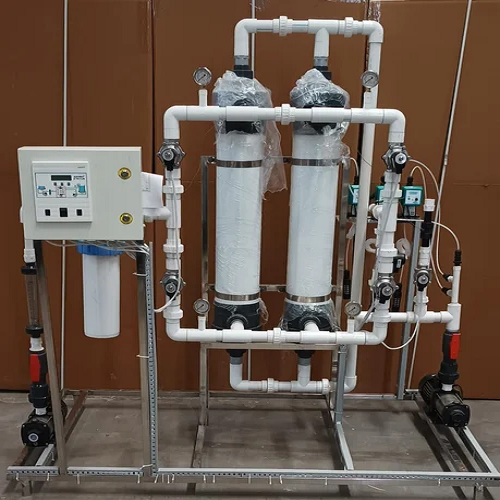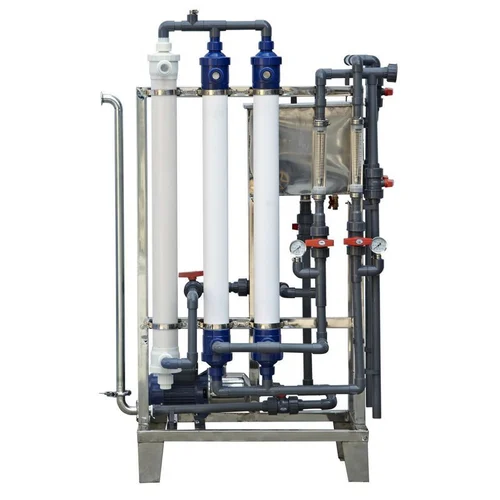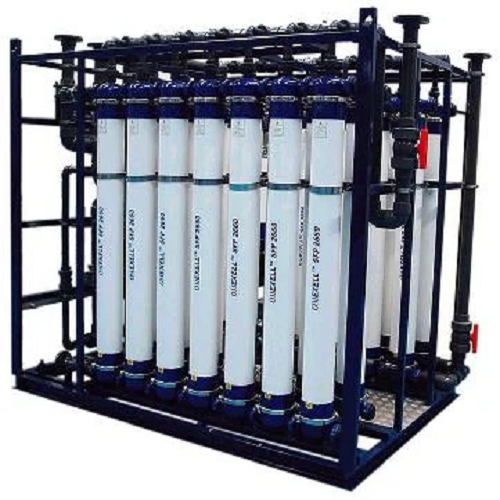
our category
ULTRAFILTRATION PLANT (UF)
An Ultrafiltration (UF) Plant is a water treatment system that uses membrane filtration technology to remove suspended solids, bacteria, viruses, and larger molecules from water, offering a high level of water purification. Ultrafiltration is a type of membrane filtration with a pore size typically ranging between 0.01 to 0.1 microns, which allows the separation of particles such as bacteria, viruses, colloids, and larger organic molecules from water while allowing smaller molecules like salts and low-molecular-weight organics to pass through.
Enquire Now
Key Components of an Ultrafiltration (UF) Plant:
-
UF Membranes: The heart of an ultrafiltration plant is the membrane, which acts as a barrier to contaminants. These membranes are typically made from polymers such as polyethersulfone (PES), polyvinylidene fluoride (PVDF), or ceramic materials. The membrane pore size typically ranges from 0.01 to 0.1 microns, which can effectively filter out suspended solids, bacteria, and large organic molecules.
-
Membrane Modules: Membranes are housed in modules that vary depending on the type of ultrafiltration system. Common configurations include hollow fiber, spiral-wound, or tubular membrane modules. These modules are designed to increase the surface area of the membrane, providing greater filtration capacity.
-
Feed Water Pump: The feed water pump is responsible for providing the necessary pressure to push the water through the ultrafiltration membrane. The pump ensures that the feedwater flows at an appropriate rate to achieve effective filtration.
-
Permeate and Concentrate Collection:
- Permeate: The filtered water that passes through the membrane is called permeate. It is the purified water that is collected for use.
- Concentrate: The contaminants that are too large to pass through the membrane are rejected and collected as concentrate (also known as the retentate). The concentrate may need further treatment or disposal depending on the application.
-
Backwash System: Ultrafiltration membranes need to be cleaned periodically to remove accumulated contaminants and prevent fouling. The backwash system periodically reverses the flow of water, cleaning the membrane surface and dislodging the accumulated particles.
-
Chemical Cleaning System: In addition to backwashing, chemical cleaning may be required to remove more stubborn fouling, scaling, or biofilm buildup on the membrane surface. Chemical cleaning involves using specific chemicals (such as acid, alkali, or detergents) to restore the membrane’s performance.
-
Control Panel and Automation System: The control panel monitors and controls the entire ultrafiltration process. It includes sensors to measure flow rates, pressures, and water quality parameters such as turbidity and conductivity. The automation system helps optimize the operation of the plant, ensuring efficient filtration and managing the cleaning cycles.
-
Distribution and Storage System: After filtration, the permeate is distributed for use or stored in tanks for later use, depending on the application.
Working Principle of an Ultrafiltration (UF) Plant:
-
Feed Water Entry: Raw water (feed water) is pumped into the ultrafiltration plant, where it enters the filtration unit under pressure.
-
Filtration: The feed water flows through the ultrafiltration membrane. As the water passes through the membrane, particles such as suspended solids, bacteria, and other larger molecules are trapped on the membrane surface, while the clean water (permeate) passes through the membrane’s pores.
-
Separation of Contaminants: Contaminants like bacteria, viruses, organic material, and particulate matter are retained by the membrane while water molecules pass through the membrane, resulting in purified water. The particles that are rejected form a concentrate, which is directed to a waste stream or further treatment system.
-
Backwashing and Cleaning: To prevent clogging and fouling of the membrane, backwashing is done periodically. During backwashing, the flow direction is reversed, and water is forced back through the membrane to remove accumulated solids. Additionally, a chemical cleaning process may be employed if backwashing alone is not sufficient.
-
Permeate Output: The filtered water (permeate) is collected and can be sent for further use, storage, or distribution depending on the application.
Applications of an Ultrafiltration (UF) Plant:
-
Drinking Water Treatment: UF plants are used in municipal and industrial water treatment to produce clean and safe drinking water. They are effective at removing bacteria, viruses, and suspended solids from raw water sources such as rivers, lakes, or groundwater.
-
Wastewater Treatment: UF technology is commonly used in wastewater treatment plants to purify and recycle water. It is used to treat effluents in industries such as food and beverage, pharmaceuticals, textiles, and chemicals.
-
Food and Beverage Industry: UF is used in the food and beverage industry for applications like juice clarification, milk and dairy processing, and the filtration of other liquids to remove particulate matter and microorganisms.
-
Pharmaceutical and Biotechnology: The pharmaceutical industry requires high-purity water for manufacturing, cleaning, and laboratory applications. UF is used to remove contaminants and bacteria from water used in the production of medicines, vaccines, and biotech products.
-
Desalination Pre-treatment: Ultrafiltration is often used as a pre-treatment step in desalination plants to remove suspended solids and other contaminants from seawater before reverse osmosis (RO) processes, ensuring the longevity and efficiency of RO membranes.
-
Swimming Pools and Aquaculture: UF systems are used in swimming pool filtration systems and aquaculture facilities to maintain water quality by removing fine particles and microorganisms, ensuring the water remains clean and safe.
Advantages of an Ultrafiltration (UF) Plant:
-
High Efficiency: UF provides effective removal of bacteria, viruses, colloids, and suspended solids, offering a high level of filtration with relatively low energy consumption.
-
Low Operating Costs: Compared to other filtration methods like reverse osmosis (RO), ultrafiltration generally has lower energy consumption and operating costs. It requires less pressure and chemical use, making it cost-effective for many applications.
-
Minimal Chemical Use: UF operates without the need for extensive chemicals, unlike other processes such as coagulation or flocculation. It is an environmentally friendly option for water treatment.
-
Compact System: Ultrafiltration systems are typically compact, requiring less space for installation compared to other water treatment systems, making them suitable for small or space-limited facilities.
-
Scalability: UF systems can be designed for a wide range of capacities, from small-scale applications to large industrial and municipal-scale plants.
-
Consistent Water Quality: UF ensures consistent water quality by removing microorganisms and particulates from the water, providing high-quality effluent.
Disadvantages of an Ultrafiltration (UF) Plant:
-
Fouling and Membrane Maintenance: The most common issue with UF systems is fouling of the membranes, which occurs when particles, bacteria, and organic matter accumulate on the surface. This requires regular cleaning and maintenance of the membranes.
-
Limited Removal of Dissolved Solids: While UF effectively removes larger particles and microorganisms, it does not remove dissolved salts, minerals, or chemicals. For complete water purification, UF is often used in combination with other treatment technologies like reverse osmosis.
-
Initial Capital Investment: The initial investment in UF technology, including the cost of membranes and system installation, can be higher compared to simpler filtration technologies.
-
Water Recovery: The recovery rate in UF systems is typically lower than in reverse osmosis systems. This means more feedwater may be required to produce a given amount of purified water.
Maintenance of an Ultrafiltration (UF) Plant:
-
Membrane Cleaning: Regular cleaning of membranes is essential to remove fouling caused by particles, microorganisms, and organic matter. Cleaning is typically done with backwashing or chemical cleaning.
-
Monitoring System Performance: The performance of the ultrafiltration plant should be regularly monitored by checking parameters such as flux rate, pressure, and permeability of the membranes. This helps in identifying fouling or membrane degradation.
-
Membrane Replacement: Over time, membranes will degrade and require replacement. Monitoring the lifespan of the membranes and replacing them as necessary is critical for maintaining system efficiency.
-
Monitoring Water Quality: The quality of the permeate should be checked regularly to ensure that the system is producing the required level of filtration and meeting water quality standards.
Conclusion:
An Ultrafiltration (UF) Plant is an efficient and reliable water treatment technology that provides high-quality filtration by removing suspended solids, bacteria, and larger molecules from water. It is widely used across various industries, including drinking water treatment, wastewater treatment, food and beverage processing, and pharmaceutical applications. With its low operational costs, high efficiency, and minimal chemical usage, UF technology is a preferred choice for many applications requiring consistent, high-purity water. However, regular maintenance and cleaning of the membranes are essential to ensure the long-term effectiveness of the system.


